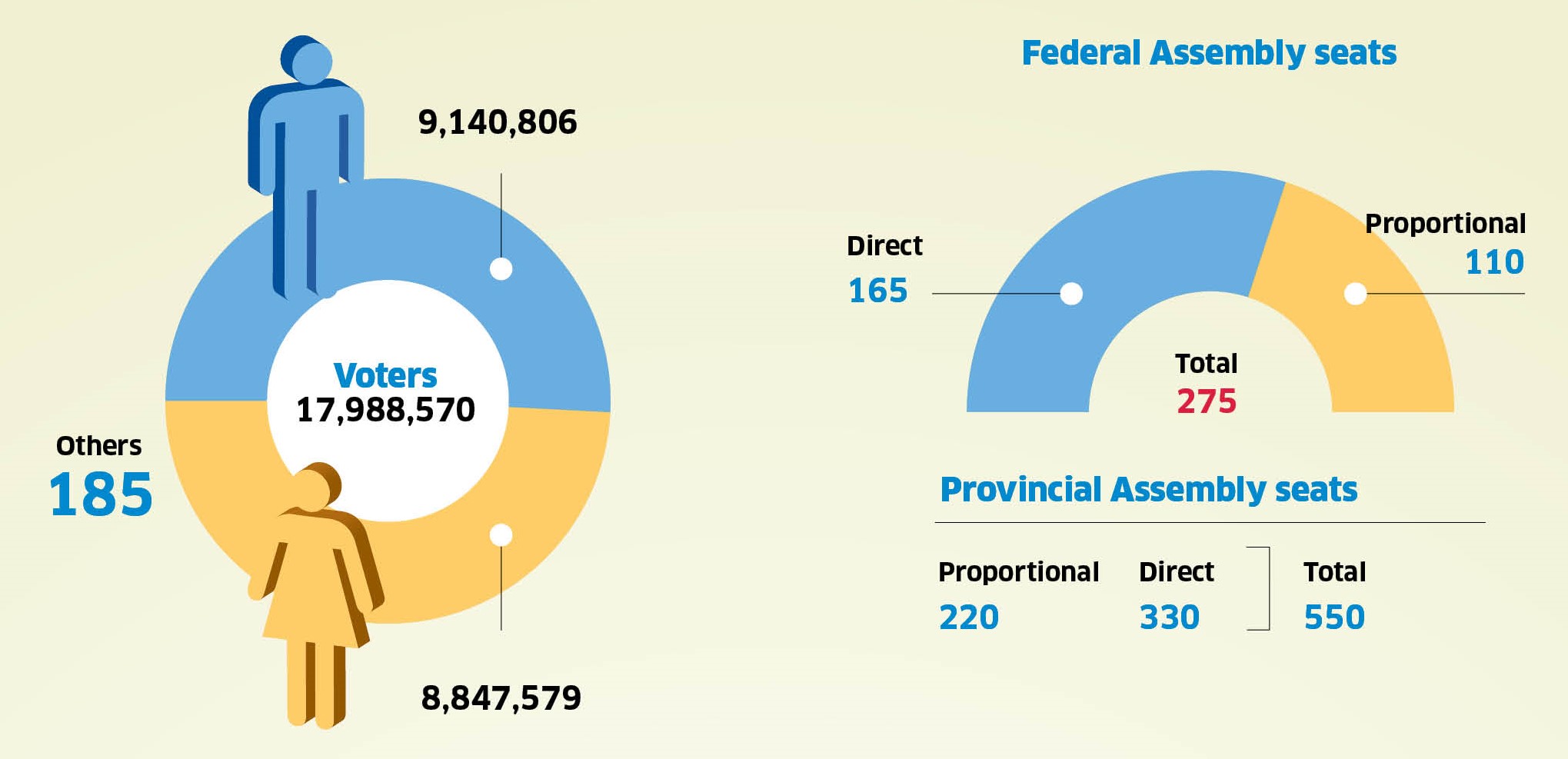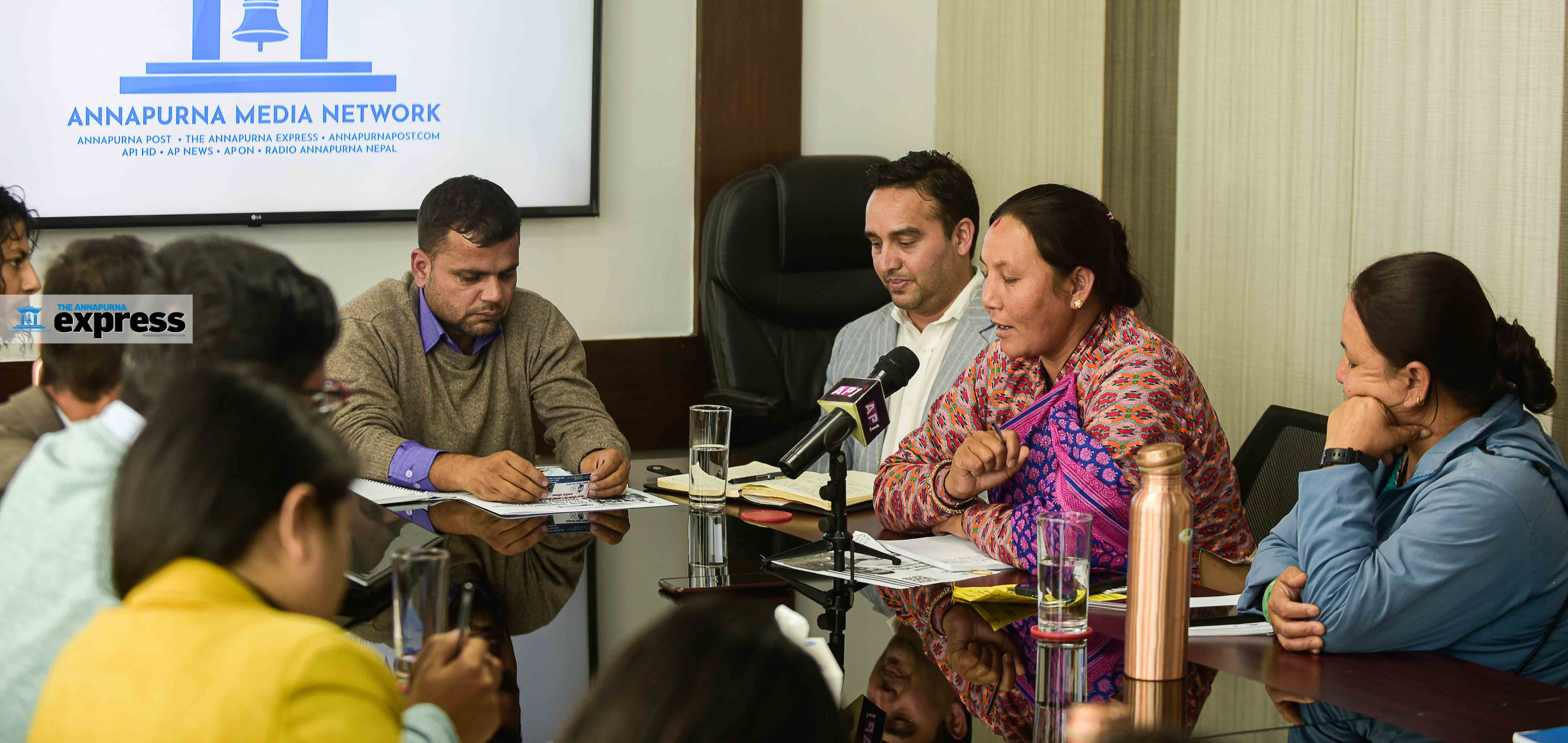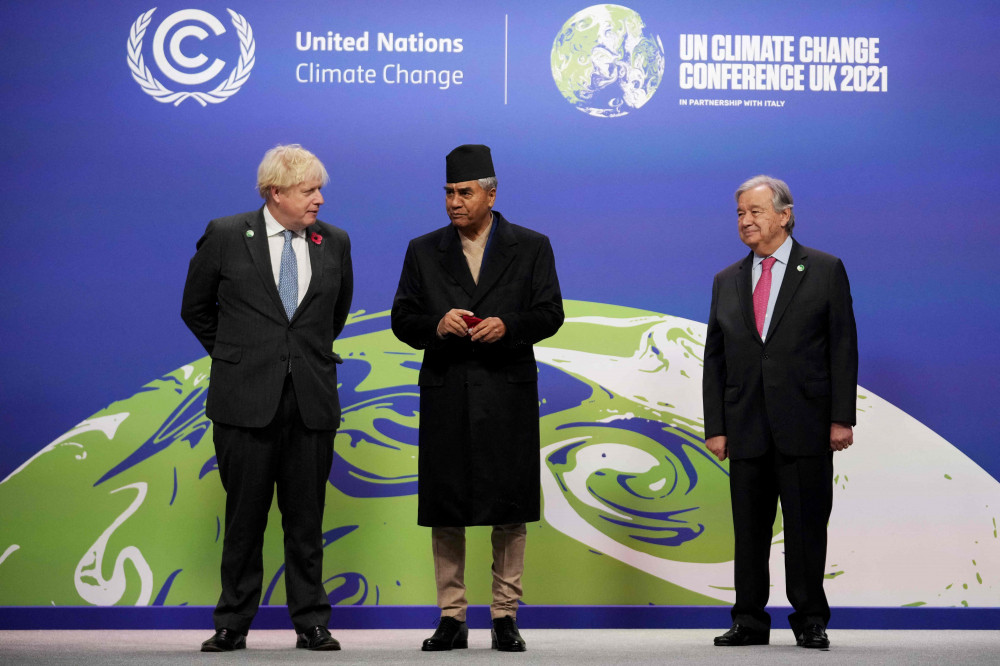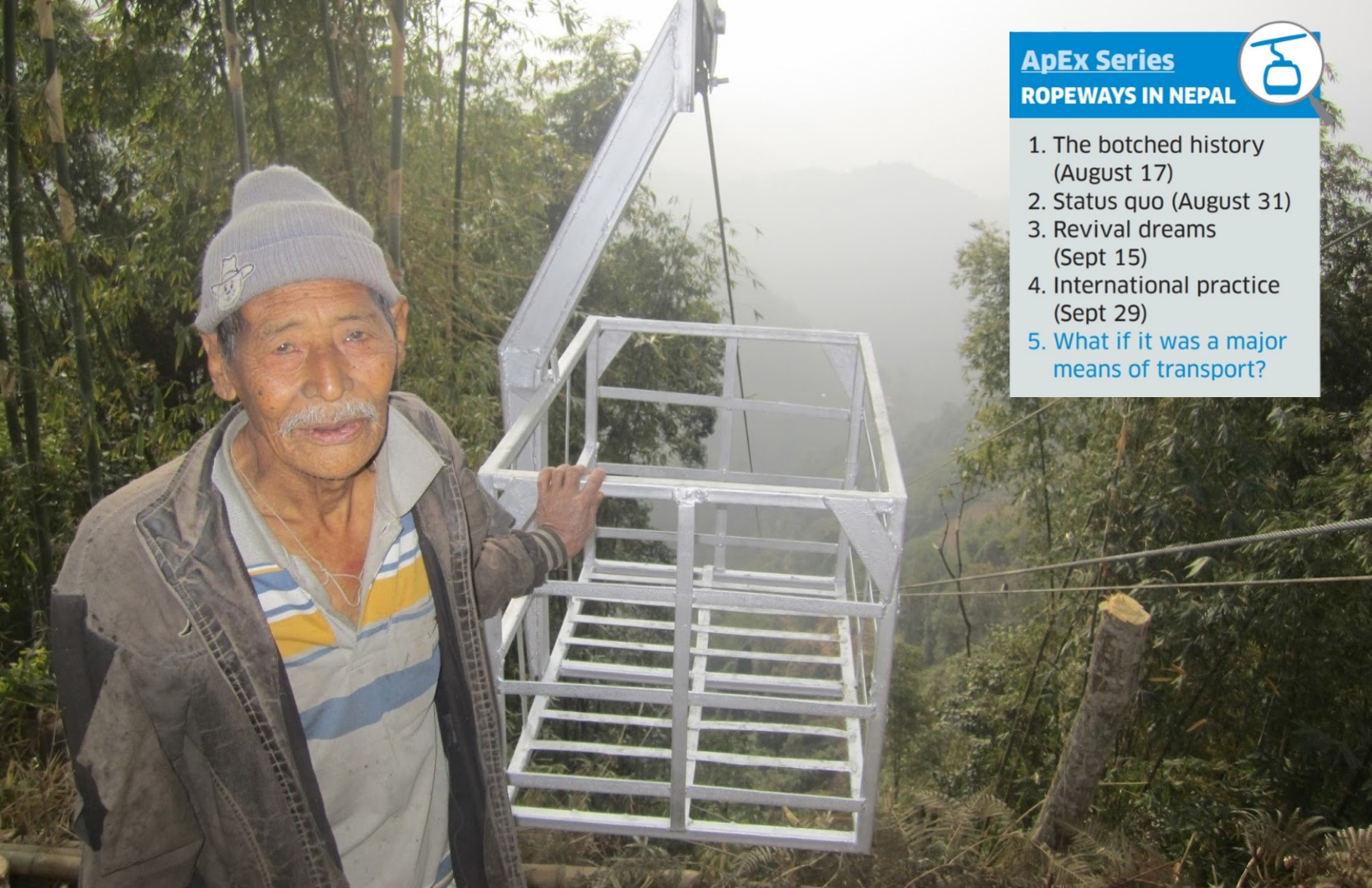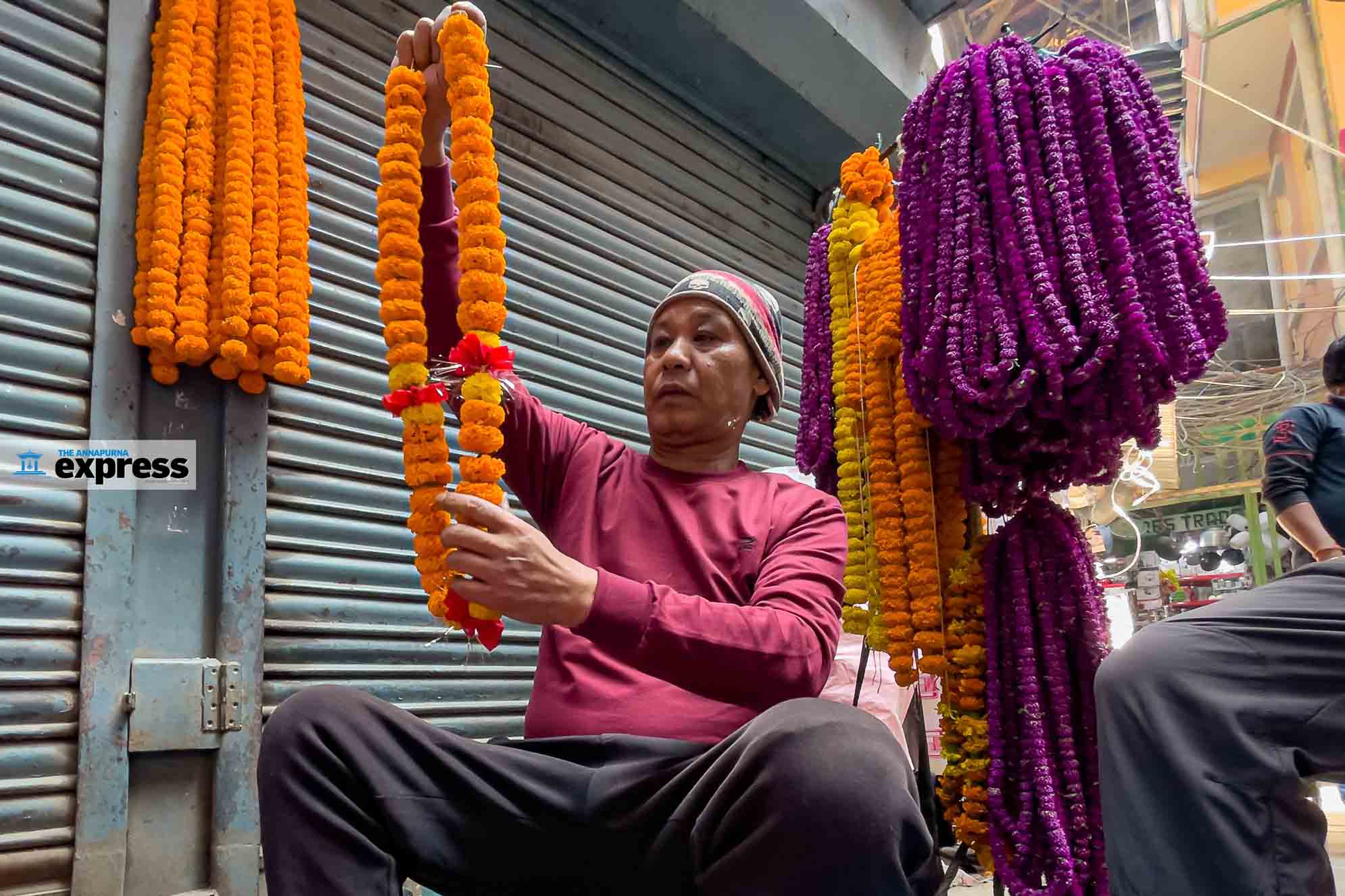ApEx Explainer: Everything you need to know before Nov 20 polls
The local level election held on May 13 was the second of its kind after Nepal adopted federalism. It elected representatives in six metropolitan cities, 11 sub-metropolitan cities, 276 municipalities, and 460 rural municipalities. On Nov 20, the country will once again head to voting stations to elect representatives to the federal parliament and seven provincial assemblies. The polls, which will elect 825 representatives in the federal parliament and provincial assemblies, are being held in a single phase. Here is an explainer on the elections.
How is the federal parliament formed?
The House of Representatives (lower house) and the National Assembly (upper house) make up the federal parliament. The lower house has 275 seats of which, 60 percent (165 seats) are chosen through first-past-the-post (FPTP) electoral system, while the remaining 40 percent (110 seats) will be elected through a proportional representation (PR) basis. The PR system aims to ensure representation of women, Dalits, Madhesis, indigenous groups, and minorities in the governing structures. Article 85 of the constitution says: “Unless dissolved earlier, the term of the HoR shall be of five years.”
The previous federal and provincial elections took place in two phases in November and December 2017. So, this December will be the end of the five-year term of parliament. The constitution has not envisioned a parliamentary vacuum of over six months; hence it was necessary to conduct parliamentary elections within six months of December 2022. But Nepal didn’t enter this period, as the government announced the elections before December.
However, the Nov 20 election is not for the National Assembly (NA) or the upper house. The NA is a 59-member permanent body, with 56 members chosen by an electoral college consisting of provincial assembly members and village and municipal executive members. The president nominates three members. It has a term of six years, with one-third of its members retiring every two years on a rotational basis.
What about provincial assemblies?
Provincial assemblies are unicameral legislative bodies. The numbers of provincial lawmakers vary from one province to another. Unless dissolved earlier according to the constitution, the term of these assemblies is five years. Their term may be extended for a period not exceeding one year in cases where a proclamation or order of the state of emergency is in effect. As provincial assembly elections were held simultaneously with the federal elections in 2017, the end of their tenure was also in December 2022. Under the FPTP component, twice as many members are elected to provincial assemblies as are elected to the HoR. And just like the lower house of federal parliament, 60 percent of provincial assembly seats are filled through the FPTP system and 40 percent through PR basis.
Province 1 has 93 seats, Madhes has 107, Bagmati has 110, and Gandaki has 60 seats in their respective assemblies. Similarly, Lumbini Province has 87 seats, Karnali has 40, and Sudurpaschim has 53 seats. Altogether, there are 550 seats in the seven provincial assemblies.
What is the role of the Election Commission?
The Election Commission is a constitutional body responsible for conducting and monitoring elections, as well as registering parties and candidates and reporting election outcomes. However, it cannot announce dates for any election. Only the government holds this right. For a long time, the commission has been making a case for its right to do so. According to former commission officials, giving the commission such a mandate will ensure timely elections. As the government has the right to announce dates, the ruling parties often tend to declare elections at their convenience.
Is there any change in our electoral system?
Even though there was a debate about changing the electoral system, Nepal is still following the same election system: a mixed voting system based on FPTP and PR. Ruling coalition partner CPN (Maoist Center) had proposed a completely proportional election system, citing that elections are becoming costly and adopting a fully PR electoral system was a solution. Other parties like the Nepali Congress and CPN-UML did not accept the proposition. A party has to cross the election threshold of three percent of the overall valid vote to be allocated a seat under the PR method. And to be a national party, a party should have at least one seat from FPTP and one from PR in the lower house.
Who can vote?
Those Nepalis who are 18 years old and are registered on the voters’ list of the poll body can vote. As soon as the government announced the election, the Election Commission stopped the voter registration process. And if you didn’t register before the cut-off time, you missed the voting rights this time. The next voter registration process will resume soon after the upcoming elections ends.  If you are a registered voter, you can vote by showing your Voter ID or other government-issued IDs at your respective polling station. Newly registered voters can collect their Voter IDs from the polling centers.
If you are a registered voter, you can vote by showing your Voter ID or other government-issued IDs at your respective polling station. Newly registered voters can collect their Voter IDs from the polling centers.
How many types of ballot papers are there this time?
Each voter has to vote on four separate ballot papers this time. There are two ballots (FPTP and PR) for the HoR and two (FPTP and PR) for the Provincial Assembly. For the FPTP election system of the HoR and the PA, the ballot paper has the election symbol and other details printed in red on a white background. While in the PR election system, the ballot paper has black color printed on a white background. 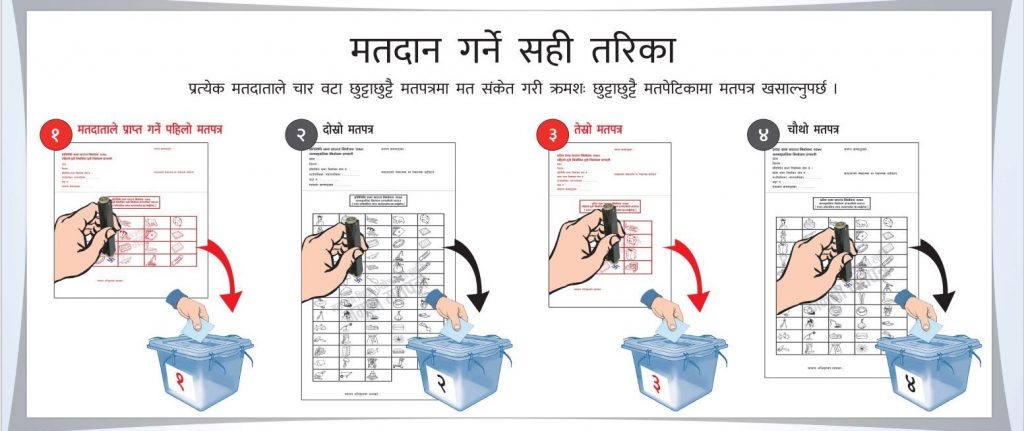 Remember, under the FPTP system, you are directly voting for a candidate of your constituency. Under the PR system, you are voting for a party and the party, if it passes the stipulated threshold, will send as many PR candidates as the seats it won to parliament. The parties have already submitted their PR list to the commission and they will be called up in an already-fixed serial order. There will be four separate ballot boxes as well. Each voter will first get the FPTP ballot paper for the HoR election. After casting the vote in the respective ballot box, the voter will get a PR ballot paper. The same pattern will follow for the provincial assembly.
Remember, under the FPTP system, you are directly voting for a candidate of your constituency. Under the PR system, you are voting for a party and the party, if it passes the stipulated threshold, will send as many PR candidates as the seats it won to parliament. The parties have already submitted their PR list to the commission and they will be called up in an already-fixed serial order. There will be four separate ballot boxes as well. Each voter will first get the FPTP ballot paper for the HoR election. After casting the vote in the respective ballot box, the voter will get a PR ballot paper. The same pattern will follow for the provincial assembly.
How to reduce invalid votes?
There are a few things you need to do to make your votes count. When you get your ballot paper, check if it has the signature of the voting officer. Use the ‘Swastik’ stamp, which is available in your polling booth, to mark your ballot paper. And make sure to stamp it clearly. Don’t use more or less ink and just stamp it once. 




You should only stamp a single electoral symbol on each ballot paper to make your vote valid. Do not cast a vote for multiple symbols. You can neither divide your vote for two symbols. Make sure that your stamp is inside the set box. Do not put your stamp outside the box. It must not overlap with another, horizontally or vertically to make the vote valid. The last part is folding your ballot paper, which is where many people fail. Fold it in a way that the ink does not get smudged or leave an imprint on any other symbol. Be mindful of where the ink stamp is and where it can leave an imprint. It is also a good idea to make sure that the ink has dried before you fold the paper.
You also need to maintain the secrecy of your vote. Do not fold the ballot paper in a way the face of the paper is turned outside. Visit the social media of the Election Commission for a better video graphical explanation of how to make your vote valid.
Why is there no electronic voting machine?
According to Chief Election Commissioner Dinesh Thapaliya, the commission had no problem using the electronic voting machine (EVM), but there was no political consensus regarding its use. The Election Commission had held talks with the leaders of several political parties several times to introduce EVMs, but to no avail.
Could Nepalis outside Nepal vote?
In 2018, the Supreme Court issued a directive to the government, parliament, and the Election Commission to make necessary arrangements to ensure voting rights for all Nepalis living abroad. But this order has been ignored. None of the stakeholders have any valid reason as to why this is. Even though the Maoist Center and the Nepali Congress had said that they would make it possible for Nepalis living abroad to vote, there have not been any positive results. The Election Commission officials say that the parties lack consensus on the matter. Election experts also suggest that political commitment, necessary laws, and resources are a must for this provision. So Nepalis based abroad cannot vote in this election.
What will the country get after the polls?
Same as now, a multi-party, federal democratic republic and parliamentary form of government will be formed after the election. As soon as the members of parliament are elected, it will elect a prime minister, who is the executive head. The leader of the party that wins a simple majority is invited to form the government. The prime minister will then form a cabinet. Similarly, the members of the provincial assemblies will choose chief ministers to run the respective provincial governments. As for the president and vice president, they are constitutional posts with nominal power. An electoral college formed by the two houses of federal parliament and Provincial Assembly members will elect them.
Nov 20 polls in numbers
Over 12,000 candidates are contesting the elections for 825 seats in federal and provincial elections. According to the Election Commission, 1,7985,570 voters will exercise their right to vote. Morang district has the highest number of voters for the elections with 735,525 people on the voter's list in six constituencies. The least number of voters is in Manang district with a total of 6,779 in a single constituency.
Violations of the election code of conduct have increased as the election draws near. So far, 71 complaints have been filed at the commission. The Nepal Police has deployed a large number of security personnel across the country to ensure that the elections are held in a peaceful environment. The police have prepared to mobilize 186,693 security personnel in all seven provinces.
According to the integrated security plan, along with the Nepal Police, there are 115,000 temporary police. The Nepali Army is also ready to mobilize 75,000 security personnel. Similarly, the Armed Police Force (APF) is set to mobilize around 35,000 security personnel. The responsibility of APF is to provide security at the Chief Electoral Office, Election Office, and District Election Office. 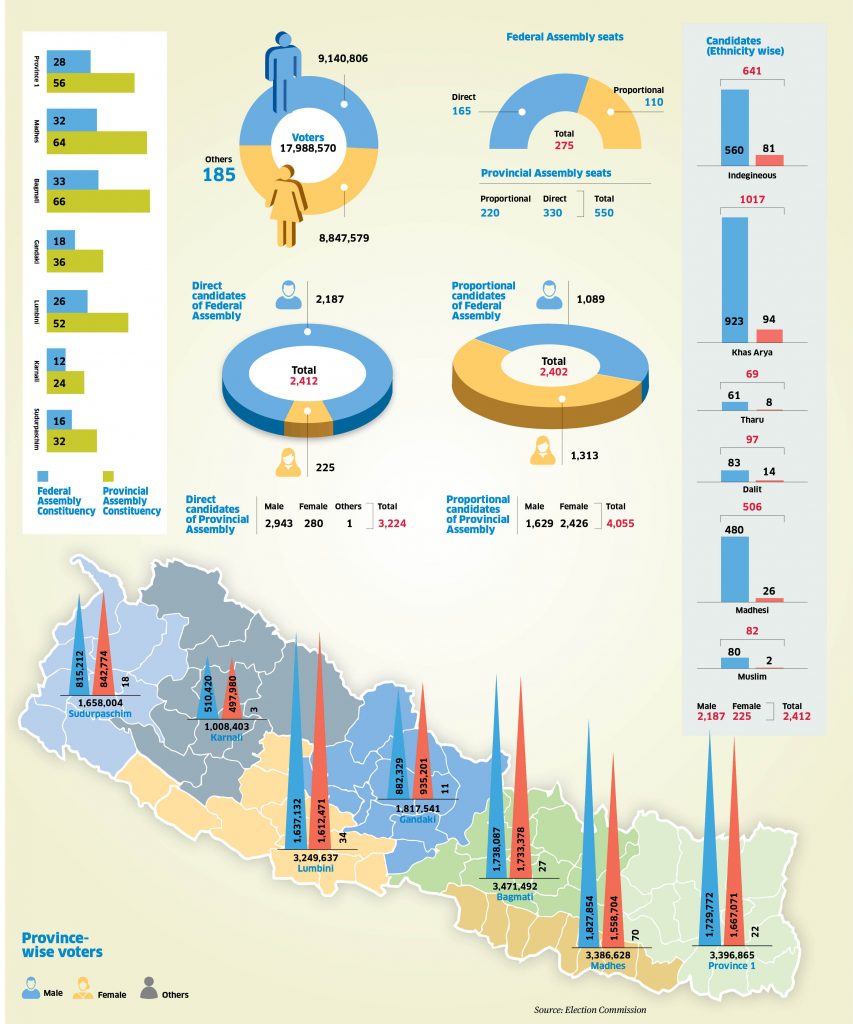
It’s estimated that Rs 24.11bn will be spent on the Nov 20 elections. The security forces have asked for Rs 16bn. The Ministry of Finance, however, has agreed to spend Rs 8.822bn on security.
For the first-past-the-post election system of the House of Representatives and the Provincial Assembly, the ballot paper has the election symbol and other details printed in red on a white background. While in the proportional election system, the ballot paper has black color printed on a white background.
Each voter has to vote on four separate ballot papers. There are two ballots (first-past-the-post and proportional) for the House of Representatives and two (first-past-the-post and proportional) for the Provincial Assembly.
ApEx Roundtable: Independent candidates on provincial assembly elections
Come Nov 20, Nepali voters will elect their representatives to the federal parliament and seven provincial assemblies. Political parties and candidates are out campaigning. But it appears as though the electioneering is gaining momentum only for the federal parliament. Elections to the seven provincial assemblies seem to have been overshadowed by the typical campaigning razzmatazz for federal polls. The constitution envisions three tiers of government, so what goes on in provinces are equally important for voters.
Considering this importance, ApEx recently organized a roundtable with four independent youth candidates contesting for provincial assembly seats to find out about their election agendas. Excerpts.
Robust provinces for a prosperous country
Jagannath Lamichhane, Kathmandu 5 (2)
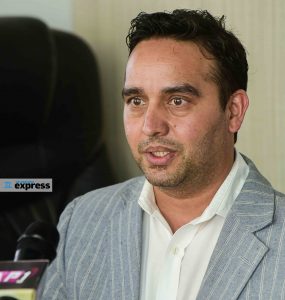
Our political leadership has made the provinces a place to install their cadres. This suggests that they are against federalism. This has set a negative narrative regarding the provinces among the public and has kept the provincial assemblies and elections in shadows. But we must realize that, in federalism, there will be no local levels without provinces as all the three tiers of government are interrelated. Bagmati province generates almost 40 percent of the country’s Gross Domestic Product (GDP), and around 90 percent of total investment goes to this province.
Being such an important province, it could be a center for the country’s economic development. So it is necessary to develop a culture of identifying and implementing development plans based on the suggestions of experts, rather than political parties. As an independent, I am campaigning with the agendas of minimum living cost, affordable housing, inflation control, community center (with public library, café, mental health, career counseling, etc.), sustainable urban development, and digitalization.
Women’s participation key to institutionalizing federalism
Sabita Maharjan, Lalitpur 3 (1)
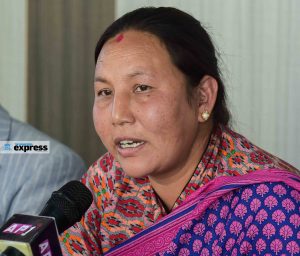
Even if our constitution has mandated 33 percent women’s participation in each sector, this has not been implemented in a real sense. In the federal parliament, there are a few female lawmakers, but in the provinces, I have not seen anyone. This is one of the reasons why I decided to contest the provincial election. Although Nepal is said to have made significant progress in terms of political and socio-economic aspects, a common Nepali person hasn’t been able to taste and experience these achievements. This is because we have yet to institutionalize federalism. In a well-functioning federalism, the general people can see the progress around them, as all levels of government are connected. I strongly believe that women’s participation is a must to institutionalize federalism and bring about real change.
My constituency has many problems that I have identified. There are issues with drinking water, sewage management, social security fund, agriculture, etc. but nobody has shown the commitment to resolve these problems. But if I were to be elected, I would take the necessary steps to deal with these problems. I have been involved in social work and empowerment of single women for more than a decade. I believe that my work experience will help me connect with the issues that need addressing.
Will set an example of what provincial assembly member should be like
Sasmit Pokharel, Kathmandu 5 (1)

A change in the system is a great deal for a country. But we Nepalis have the tendency of easily accepting a political change. We accepted federalism but the political parties took it for granted. Today, it seems like the parties themselves don’t want federalism. In the Bagmati assembly, there are 110 members, and three of them have served as the chief minister and almost 60 as ministers. The same case applies with other provinces. There has been no political stability at all. If the political parties continue these types of practices, why should Nepalis believe them?
So my argument is if a few independent candidates were to be elected in provinces, we could become examples of what real lawmakers should be like. My presence in the provincial assembly will ensure public discussion, public decisions, good governance, meritocracy, integrity, and transparency. I believe in teamwork. I will also forward a concept of provincial universities, as a large number of Nepali students are going abroad because we lack decent educational institutions. As a provincial assembly member, I will also focus on health insurance, digitization of services and promotion of art and culture.
Will build youth-focused entrepreneurial province
Suraj Raj Pandey, Kathmandu 1 (2)

Our constitution has ensured a check and balance among all three tires of government. But what our politicians have been doing is fooling Nepalis by recruiting their puppets in provincial assemblies. There is no political discipline, no programs or policies for development. Every sector is paralyzed as a result. I am an entrepreneur and I have no working environment in this country. So why will I stay here and struggle for no reason? This is the voice of present youths. Nearly 90 percent of my friends have left Nepal. The problem of brain drain is real, but no politician acknowledges it, let alone tries to address it. We can’t make a prosperous country by relying on remittance. If I get elected, my first focus will be to create a youth-friendly entrepreneurial environment in Bagmati province. For better educational activities, my concern will be in the promotion of skillful education and the betterment of community schools.
Nepal is a young country and it needs a government led by youths. So my objective will be to encourage youth engagement and participation in all sectors. My other priorities will be creating jobs, addressing the problem of drug abuse among youths, affordable healthcare and working closely with the Kathmandu Metropolitan City to find sustainable solutions for parking, waste management.
Constitutional provisions for provincial assemblies
The main functions of the provincial assembly are to form the government, make provincial laws, monitor the activities of the provincial government, and discuss provincial public affairs issues in the assembly meeting. According to the provisions of Part 13 (Provincial Executive), Part 14 (Provincial Legislature), Part 15 (Provincial Management Procedures), and Part 16 (Provisions on Economic Procedures) of the constitution, the Provincial Assembly has to enact the following laws related to:
- Determining the language of state government work
- Grants received from the Government of Nepal and financial normalization grants to subordinate local bodies from their own revenue
- Establishment of judicial bodies at the local level
- Work, duties and powers, and other conditions of service of the advocate general
- Certification of authority in the name of the head of state and the decision or order of the state government
- Remuneration and facilities and oath of the chief minister and the cabinet
- Provincial government work division and work execution regulations
- Extension of term of the provincial assembly
- Privileges of provincial assemblies
- Rules of the provincial assembly
- Service conditions of the provincial assembly secretariat, secretaries, and employees
- Remuneration and benefits of the speaker, deputy speaker, and members of the assembly
- Provincial contingency fund
- Provincial financial procedures
- Operation of the district assembly, the facilities of the members of the DCC
- Procedure for making laws of rural municipal assemblies and municipal assemblies
- Other provisions of rural municipal assemblies and municipal assemblies
- Equal protection, treatment, and facilities accorded to residents of another state in their own state
- Procedures for resolving political disputes between local levels and provinces
- Work, duties, and rights of provincial public service commission, police, and government services
Source: Constitution of Nepal 2015
New faces of Nepali politics
The Nov 20 election is less than two weeks away. Candidates contesting the elections—ranging from 22 to 99 years old—are on door-to-door campaigns to bring voters on their side. Unlike previous parliamentary elections, this time there are a lot of independent candidates. Top political honchos find themselves pitted against new, aspiring leaders.
Here are three such independent youths who are competing against the former prime ministers.
Rahul Kumar Mishra, Rautahat-1

A 25-year-old engineer Rahul Kumar Mishra filed his candidacy for federal election from Rautahat-1. The chairman of CPN (Unified Socialist) Madhav Kumar Nepal is also contesting the election from the same constituency. Rautahat is the hometown of independent candidate Mishra while Nepal has also contested elections from Rautahat several times. In the last election, Nepal won from Kathmandu-2.
Mishra has an engineering degree from the Thapathali Engineering Campus in Kathmandu where he was president of the Nepal-Tarai student union. He is also a co-founder and vice-president of CharitAble, a group of youths working to promote practical education while encouraging youths on environmental sanitation, waste management, and carbon control. His major agenda is to make Rautahat an exemplary town in the Madhes by providing better education. He envisions facilitating community schools so that people don’t have to pay expensive fees at private schools. Mishra also wants to establish good educational institutions in Rautahat so that youths don’t have to go abroad for education and employment.
Sagar Dhakal, Dadheldhura-1

Independent candidate Sagar Dhakal is 31 years old. He is a hydro-mechanical engineer graduate from Pulchowk Engineering Campus in Lalitpur. He also has a policy and management degree from Oxford University. Dhakal says he got involved in politics after thinking about how Nepal can be developed in the next 50 years. Though his hometown is Gulmi, he is contesting parliamentary elections from Dadhedhura-1. He says he has seen more problems in the district of Nepali Congress President and Prime Minister Sher Bahadur Deuba than in his own district. I
n 2017, Dhakal came into the limelight after a heated exchange with Deuba on live TV. He says that people under 40 should run the country. His electoral slogan is ‘Direct leadership of the youth, advice of parents, respect and rest for the grandparents’—meaning youths like him should run the country and second-generation political leaders should have an advisory role while Deuba, Oli, Dahal, and the others should now rest.
Yug Pathak, Jhapa-5

Yug Pathak, 44, is a writer, journalist, and political commentator. He filed his candidacy for the federal election from Jhapa-5, hometown of former Prime Minister and Chairman of CPN-UML KP Oli. Pathak was born and brought up in Makawanpur but he chose Jhapa for the election which he calls ‘Oozelution Movement’, a campaign against Oli. Pathak was also a leader of the civil society movement ‘Brihat Nagarik Aandolan’ whose aim was to fight against the unconstitutional move to dissolve the parliament by then Prime Minister Oli. He is a scholar of English literature. Two of his famous books are ‘Mangena’ and ‘Urgen Ko Ghoda’.
‘Mangena’ questions the ideologies that have been institutionalized since the Panchayat period. The book’s basic argument is that old ideologies should be discarded and new concepts should be developed to recognize and understand the current Nepali society.
Where does Nepal stand at COP?
Nepal has set four main agendas to present at the COP27 that takes place in Egypt later this week. Climate change adaptation and reduction, climate finance, specific issues of mountain region, and financing for climate losses and damages will be the priorities, according to the Oct 23 media briefing by the Ministry of Forest and Environment.
The government has also released a press note on its intent to call for a global pledge on dedicated financial facilities for loss and damage caused by climate change and locally led adaptation principles. In last year’s climate conference, Nepal had submitted a research report on loss and damage attributed to climate change.
“Relying on that document, we have framed our issues and will prioritize them,” says Megh Nath Kafle, spokesperson at the ministry. Nepal has been demanding $50bn annually as climate finance. To date, there is no exact figure as to how much funds Nepal has been getting as climate finance. Kafle says climate finance is a cross-cutting issue, where many areas overlap and interlink. “There are no clear stats on how much we are getting in climate finance. The ministry is planning to maintain real data so that we can claim our share of climate finance.”
During the COP26 held in Scotland, Nepal announced to remain cumulatively ‘net zero carbon’ from 2022-2045 and become carbon negative after that, halt deforestation and increase forest cover to 45 percent by 2030, and ensure all vulnerable people are protected from climate change by 2030.
Prime Minister Sher Bahadur Deuba also urged world leaders to recognize specific climate vulnerability of the high mountains and prioritize the mountain agenda in all climate-related negotiations. He said that keeping global temperature rise to below 1.5° Celsius was vital for the mountain people.
Madhukar Upadhya, an environmentalist and climate change expert, says Nepal’s commitments and appeals for climate action on international platforms are irrelevant. “The likes of Pakistan and Bangladesh have been much more effective in highlighting their plight in international climate forums than Nepal,” he adds. “Those countries too have internal political conflict, yet they lead the international platforms like COP.”
According to the reports presented by the Nepal government, melting glaciers, erratic and unpredictable weather conditions, changing rainfall patterns, and increasing temperatures are impacting Nepalis. But the government has failed to draw the attention of global communities on these issues. Nepal has been raising its climate-related issue through the group of Least Developed Countries (LDC) on climate change. The group comprises 46 countries that are especially vulnerable to climate change but have contributed the least to the phenomena.
Nepal is also a member of the G-77 group on climate change issues. Climate experts like Upadhya are of the view that Nepal’s climate diplomacy through the LDC group and G-77 is not yielding results. Instead of only relying on these platforms, they recommend that Nepal take the initiative to lead the mountain agenda by bringing all mountainous countries.
Nepal’s climate agenda COP22 (Morocco, 2016) 
- Informed that Nepal ratified Paris Agreement
- Associated with the statements made by Thailand on behalf of G77 and China and Congo on behalf of the Least Developed Countries
- Informed that the government prioritizes accessing and managing climate finance, upscaling of renewable energy, building adaptive capacity and resilience and implementing mitigation actions to achieve sustainable development goals
- Over 80 percent of the climate finance to local level with a dedicated climate change budget code
COP23 (Germany, 2017) 
- Urged the global leaders to implement key areas of Paris Agreement
- Sought funding support from the global community while also urged to raise relevant funding and support for calamity-vulnerable countries
- Sought developed countries’ contribution of $100bn per year by 2020 as agreed upon during the Paris COP21
- Raised questions on adaptation, mitigation measures, means of implementation and cross-cutting agendas like climate and gender
COP24 (Poland, 2018) 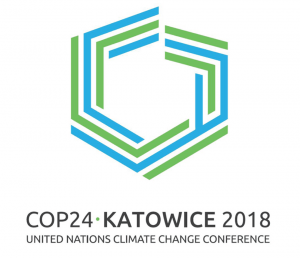
- Reported the good practices that has been carrying out to support the economic status of the local people affected by climate change as well as in the areas directly related to their livelihoods such as protection of forests, soil conservation, water management, agriculture, fruit cultivation, and livestock farming
- Raised the issues that will contribute to the concept of ‘Prosperous Nepal, Happy Nepali’ that the government had brought
- Highlighted the adverse impact of climate change on the economy of the Himalayan region as well as relating this to the marine economy
- Pursued issues related to agriculture, biodiversity, development infrastructure, and technology transfer among other topics
COP25 (Spain, 2019) 
- Prioritized three areas considering the unique needs and circumstances of the fragile mountainous region: climate finance, technology transfer, and sharing of best practices
- Encouraged the parties to come up with ambitious NDCs by 2020 in both adaptation and mitigation measures so that the objectives of the Paris Agreement can be achieved by the stipulated time
- Engaged in discussions of loss and damage, technology development and transfer, transparency, capacity building, climate finance, as well as formal and informal networks
- Requested to implement Article 6 of Paris Agreement with the assurance that financing will be provided and technology transfers will occur to benefit the least developing countries (LDCs), to make them more climate-resilient
COP26 (Scotland, 2021) 
- Called for recognizing the mountains’ climate vulnerability highlighting that around 80 percent of Nepal’s population is at risk from natural and climate-induced hazards and in the last 40 years, natural disasters have caused close to $6bn in physical and economic damage in Nepal alone
- Announced that emit ‘no net’ carbon between 2022 and 2045 and become carbon negative after
- Committed to halt deforestation and increase forest cover to 45 percent by 2030
- Urged the parties to agree on a clear roadmap for a new collective, quantified and ambitious goal on climate finance before 2025
ApEx Series: What if… ropeway was our major means of transport?
Ropeways are an ideal means of human and goods transport in Nepal, a country filled with rugged mountains and hills. In fact, installing ropeways is six times cheaper than building roads. The 42-km Hetauda-Kathmandu Ropeway, for instance, cost half as much as the Tribhuvan Highway on the same route to build. Studies suggest Nepal could have up to 2,000 ropeways and feasibility studies have been completed on 62 of them. But only five ropeways for human transport and almost a dozen gravity goods ropeways are in operation in the country.
The 22-km-long Tri Chandra Nepal Tara Ropeway came into operation in 1927, and it is believed to be one of the first ropeways in the whole of South Asia. But despite being a ropeway pioneer country in the region, Nepal’s infrastructure development has largely revolved around building roads. What if ropeways were the major means of transport in Nepal? We have to see the economic, environmental and social aspects, says Dipak Gyawali, former water resource minister. “Being six times cheaper than building roads, ropeway, for one, would have helped significantly to minimize national expenses.”
But neither the Ministry of Physical Infrastructure and Transport nor the National Planning Commission (NPC) has any plans and policies for ropeways. Chandra Mani Adhikari, economist and former NPC member, says ropeway development is certainly food for thought. “Even with the saving of 10 percent fuel, there will be a national saving of Rs 20bn,” says Adhikari. “This is important, given that Nepal imports almost Rs 200bn worth of fuel a year.” As the major goods carrying ropeways got abandoned post-2000, there is no real data on how they would have performed.
But until they were in operation, they had shown promising results. For instance, the rate fixed by the government for goods transported by the Nepal Tara Ropeway was Rs 346.80 per ton against Rs 480 charged by trucks. Provided there were sufficient goods to transport, ropeway shutdown for even a single day resulted in a revenue loss of Rs 53,407, contends Shyam Sundar Shrestha in the book ‘Ropeways in Nepal’ by Dipak Gyawali, Ajaya Dixit, and Madhukar Upadhya. Another case for the ropeway is that of Himal Hydro Project. It had three ropeways—Andhi Khola, Jhimruk and Khitmi—for transporting goods and raw materials.
The cost of hauling goods by Andhi Khola Ropeway was compared against the road, porter and mule transports by Resham Raj Dhakal, whose outcome has been published in the same book. It states that to gain 250 meters in elevation for every 1,200 meters would have required constructing three kilometers of road, which, at the prevailing prices for hill terrain, would have cost about Rs 30m. A second choice was to hire porters at an expensive cost of about two to three rupees per kilogram. Mules were available at rates up to Rs 1.5 per kilogram.
Considering the depreciation of the ropeway system and its equipment as well as the interest on borrowed capital (20 percent depreciation and 15 percent interest), the annual capital cost of the ropeway was estimated to be about Rs 805,000 (0.35×2.3m). The annual operation and maintenance costs of the ropeway system came to Rs 110,000 a year. In a year, the ropeway transported 1,300 tons of materials at the cost of Rs 704 per ton. This was three times less expensive than what porters would have charged. There are also environmental and social benefits to prioritizing ropeways over roads, particularly in a country like Nepal made largely of hill and mountain terrains.
Landslides and erosion are regular occurrences in the hill and mountain districts of Nepal. These events have been exacerbated by unplanned development projects, where large swathes of forest covers are denuded. During this Dashain festival alone, over 20 people died and properties worth millions were damaged or destroyed as a result of landslides. Rastriya Samachar Samiti, the state news agency, reported the death of seven members of a family in an incessant rainfall-triggered landslide that buried their house at Barkotebada, Kanaksundari Rural Municipality-5, Jumla, on October 8.The rainfall also blocked and damaged roads in many places in the highland district.
Government data suggest that, on an average, 2,500 people are killed in road accidents every year while thousands of others are injured. Globally, Nepal is among the countries with highest death rates caused by road accidents. These road accidents not only affect the families, but they also have a bad impact on the national economy. “If we had adopted ropeways, these disasters and fatalities would have been minimized,” says Gyawali. Besides causing disasters and fatalities, unplanned development projects are also damaging our environment in general, says Bhushan Tuladhar, clean energy campaigner. “Our constitution mentions a clean environment as a fundamental right of citizens. Yet, international studies show that every year approximately 42,000 Nepalis die from air pollution,” says Tuladhar. “So yes, ropeways would have been a good idea.”
Flower business booms
Tihar is incomplete without sayapatri (marigold), makhamali (globe amaranth), and godavari (chrysanthemum). The Floriculture Association of Nepal (FAN) suggests around 2.45m garlands (usually a meter long) will be sold in the market this Tihar. Of them, around 2m will be sayapatri, 0.42m makhamali, and the remaining are godavari. Last year, around 1.85m garlands (1.5m sayapatri) were sold.
Demand for flowers increases by around 15 percent every year in Nepal. Where makhamali is concerned, Nepal is planning to export around 0.1m of garlands. But, to supply enough sayapatri in the market, florists are bringing flowers from India. 15 percent, i.e. 0.3m garlands are expected to come from India.
According to FAN, the price of sayapatri garlands will not be more than it was last year. It will be sold for Rs 60 to 70 per garland this year too. In Tihar, flowers worth Rs 130m will be sold. Annually, this transaction reaches up to Rs 400m. Unlike the previous Tihar, there is very little retail footpath business of flowers this time. “Balen business-free-footpath campaign has hampered this year’s Tihar as there is no crowd on the streets of Ason,” says Tularam Nakarmi, a street vendor.
Along with the increase in demand for flowers, commercial floriculture has expanded to 28 districts, including Kathmandu, Lalitpur, Bhaktapur, Kaski, Chitwan, Gulmi, Palpa, and Morang. Nepal currently produces 450 species of flowers commercially. They are cultivated by over 700 farmers in an area of about 157 hectares.
Dr Sher Bahadur Pun: It’s time to reconsider the status of covid
Covid-19 was first reported in Wuhan, China, in December 2019 and soon spread globally. In January 2020, the World Health Organization (WHO) declared it a pandemic, the fifth distinguished pandemic since the 1918 Spanish flu. Now, after almost three years, the threat of Covid-19 has largely subsided. Pratik Ghimire of ApEx talks to virologist Dr Sher Bahadur Pun, who is also the chief of Clinical Research Unit at Kathmandu’s Sukraraj Tropical and Infectious Disease Hospital, about the Covid-19 status both in Nepal and globally.
Can you explain the present global situation of the Covid-19 pandemic?
Though there are still active covid cases, it has significantly decreased compared to the previous years. Once the pandemic starts, there could be no end of cases, but that doesn’t mean it could hamper the lifestyle for ages. Most of those who have tested positive in recent times were asymptomatic or not seriously ill.
Is there any possibility of the next deadly wave?
I don’t think so. Even if new waves were to arrive, there are negligible chances of it being deadly like the first and second waves. Not every mutation needs to be deadly. The logic behind this is many people have already tested positive which has created antibodies in their bodies. Besides, a large number of the world population has been vaccinated against covid.
Is there any time limit for a pandemic to end, and do you think it time to downgrade Covid-19 as a communicable disease?
There is no certain duration to ascertain whether a pandemic is over or not. It works on how long it affects humanity. But there is a WHO technical support group that works on the technical aspects of a pandemic. In the case of Covid-19, I personally think that the time has come to reconsider its status as a pandemic. Though few countries are still witnessing a significant amount of covid cases, the infection is not as deadly as it was previously, thanks to the protocols they have adopted against the disease.
China is still adopting strict measures against Covid-19. What do you think is the reason behind this?
China has introduced a zero-covid policy, which emphasizes zero cases in the country. The policy aims to prevent the spread of the coronavirus. To achieve this goal, China has introduced harsh measures and implemented strict lockdowns and mass testing. I personally am not convinced with this policy. It is difficult to make a country with the world's largest population free of Covid-19 infections. There may be cases as the virus has been detected in the swabs. But the concern should be if the infection has entered the patient’s lungs. As I said before, there are some countries with significant covid cases but they are not deadly. This is because of the covid vaccines. I don’t think we should be comparing the present situation with the previous ones. The scenario has changed with the arrival of vaccines.
Has Nepal become free of covid threat then?
I guess so because the stats say so. Over 70 percent of Nepalis have received a complete dose of Covid-19 vaccines, which is a very good number. Scientists and health experts have assured that the double dose of covid vaccines work. Many people have also received booster doses, just in case. From our experience, we know that the coronavirus is very tricky, as it changes its form regularly. So, it should be constantly kept under surveillance. But the general public is by and large safe. They should now be free from psychological threats.



